Water, water, everywhere…
Camping in the backwoods or traveling through Mexico means you’ll need clean drinking water all day, every day. Even if you’re surrounded by enough civilization that bottled water is readily and cheaply available, it doesn’t hurt to have a portable water filter or purifier for those days when all the stores are closed, or you’re too lazy to go outside, or you see someone filling up empty water bottles from the tap to be resold in stores again. Ew.
Luckily for all of us, portable water filters have actually gotten pretty great recently. And no, I’m not talking about the well-known options that have great marketing and cost hundreds of dollars and don’t filter out viruses dammit. Why do they cost so much if they still let bugs through that’ll kill me!? Argh!
The options I’m talking about are comprehensive filtration devices, with technology so good that they’ll handle even the tiniest of microscopic organisms, which most traditional backpacking filters can’t handle. You can fill up from a stagnant pond in sub-Saharan Africa and you’ll be just fine. And isn’t that lovely?
What kind of water filter or purifier do I need?

This is where it starts getting technical, but the way I look at it, there are three major categories of contaminants worth discussing:
- Chemical: Lead, arsenic, chlorine, and iodine come to mind. These are more often found in tap water than river water, so if you’re traveling abroad (or filtering at home), you’d want something that can help with these. Dirt and dust are important to remove as well, but pretty much every filter on the market will do that. I’m not aware of anything that’ll filter out all chemicals, but carbon filtration is the most common method for handling these, and is quite helpful.
- Bacterial (and bacterially-sized things): These are the most common biological contaminants, and the most important things to filter, whether you’re traveling to another country, or hiking in your own. There are other microorganisms out there that can cause illnesses (such as protozoan cysts, like giardia and cryptosporidium), but they’re similarly sized, so if a filter can handle bacteria, they can handle the other ones too.
- Viral: Viruses, the smallest organisms on earth, bypass most filters. Viruses are pretty rare, and generally only found in rural environments in developing countries. You probably don’t need viral filtration if you’re hiking through North America or Western Europe (which is part of the reason why filters that remove viruses are so rare), but…well, if it can do it, great.
Ideally, you’d want something that can handle all three, and that’s what this list is about. To the best of my knowledge, these are the best portable water purifiers on the market today. Significantly cheaper options exist, they won’t work nearly as well as these.
This list is split into two parts, starting with…
Part 1: If you need total filtration (including viruses)
The following devices offer all-in-one filtration, including large dirt particles, harmful chemicals, bacteria and bacterially-sized microorganisms (like cysts and giardia), and viruses. If you’re going to remote areas in developing countries, viral filtration is important; if you’re hiking around North America or filtering tap water in Western Europe, you probably don’t.
There are certain things they won’t remove (salt, for example), but the options listed here offer the most comprehensive filtration on the market, and you probably won’t find something that does. These will remove all harmful biological contaminants, and certain chemicals, making tap water or river water taste great, and safe to drink.
1) Lifesaver Bottle: $150
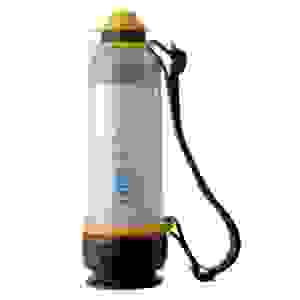
Update: It looks like the Lifesaver will be discontinued. I’m not entirely sure if this is temporary, but I’ll keep this updated if things change.
The Lifesaver Bottle was designed for the developing world, featuring an all-in-one portable water purifier that could provide clean drinking water for the 3 billion people that need it at a total investment of $20 billion. Makes you want to donate, doesn’t it?
As its design goals were simplicity and cost-effectiveness, it happens to suit the needs of backpackers and hikers just as well, and is readily available for purchase by first-world consumers, who are encouraged to participate in a buy-one, donate-one program.
The bottle has a filtration and pump system housed entirely within the bottle, so you pump a few times to press the water through the super-fine filter, and then you can drink. The bottle has a watertight cap, a carrying strap, has completely replaceable parts, and can even handle viruses.
For a while the Lifesaver was far and away the most cost-effective option on the market, though a couple new options have emerged that are lighter, don’t require pumping, and don’t need to be submerged upside down in a river to fill it up, like the Lifesaver does; but it’s still quite good.
The following numbers are estimates for the $150 Lifesaver Bottle 4000, with a limit of 4000 liters, and assume high-frequency replacement of carbon filters, available in $30 packs of 4 which treat 250 liters each. The 6000 liter version and carbon filter value packs can reduce the long-term costs listed below by about half.
- Unit price: $150 (4000 liter version)
- Replacement parts: $100 per cartridge, $8 per carbon filter, $6 per pre-filter
- Lifespan: 4000 liters (carbon filters need more frequent replacement)
- Initial water treatment cost: $0.06 per liter
- Recurring water treatment cost (replacement cartridges + filters): $0.05 per liter
- Empty weight: 22 ounces (623 grams)
Buy it here.
2) The Grayl Ultralight: $60
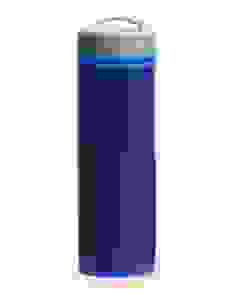
Frequently referred to as the Holy Grail of water purifiers (doesn’t everyone love puns?) the Grayl was designed by someone who got tired of drinking from sporty bottles with gigantic logos and flashy colors. This one offers the same great filtration performance as anything else you’ll find, but without the need for pumping, sucking, squeezing, or waiting.
The filter mechanism works like a French press; you fill up the lower chamber, and press the upper unit down into it. It takes about 15 seconds, after which you can drink just like you would from a regular bottle, without having to suck up the water through a straw. It also means you can pour out purified water into a cup for a friend, or fill up spare bottles for a long trip, and you’ll be hauling clean water around with you, instead of dirty water.
The Grayl has multiple filter unit options which can be swapped out according to your needs, including a low-cost tap water filter, or the top-of-the-line Purifier cartridge, which can handle viruses (removing 99.9999% of them), and 99.9999% of bacteria, along with other microorganisms and chemicals, with a 150 liter lifespan. From what I have seen, its filtration quality is the best of anything on this list.
The numbers below are for the Purifier cartridge, which is what you’d want for outdoor backpacking or international travel.
Full disclosure: They’ve provided me with some free test samples, and, years after the reviews, made me a revenue-sharing offer as well. But I like it a lot. Check out a very in-depth review here.
- Unit price: $60
- Replacement parts: $25 per cartridge (Purifier)
- Lifespan: 150 liters
- Initial water treatment cost: $0.40/liter
- Recurring water treatment cost (top-of-the-line Purifier unit): $0.16/liter
- Empty weight: 10.9 ounces (309 grams)
Buy it from TheGrayl.com.
3) Aquamira Frontier Bottle (Red Line): $50
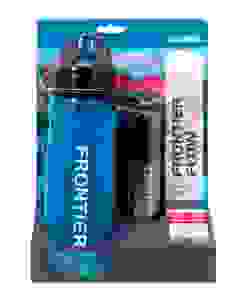
This is a recent upgrade to a previous Aquamira bottle; the new ones adds viral protection (in addition to chemical and bacterial and other microorganisms), making it seriously effective anywhere in the world.
Because it’s a recent modification to the Aquamira lineup, you’ll need to make sure it specifies viral protection (if that’s what you need, of course), and the replacement filters will be labelled Red Line. The bottle has other replacement filters, such as Green Line, but that’s for non-viral filtration (good for hiking in North America, and significantly cheaper, so it’s useful that you can swap them out as needed).
The numbers listed here are for the Red Line filter, to provide a direct cost comparison with the other top-of-the-line filters listed here, and the numbers are pretty great. It removes chemicals, 99.9999% of bacteria, and 99.999% of viruses and other microorganisms, with a 450 liter lifespan. The squishy straw is the type of thing that might need to be cleaned out every once in a while, but that’s true of most bottles anyway.
Full disclosure: The manufacturer has provided me with a few test products (though not this particular item), but all these numbers are accurate.
- Unit price: $50
- Replacement parts: $40 per cartridge (Red Line filter)
- Lifespan: 450 liters
- Initial water treatment cost: $0.11 per liter
- Recurring water treatment cost (cartridges): $0.08 per liter
- Empty weight: 5.6 ounces (158 grams)
Get it here.
They also make an in-line filter for attaching to a hydration bladder hose, which offers the same virus-removing performance, and is (at the moment) the only one I know of that does that.
4) Water to Go Bottle: $40 (approximately)
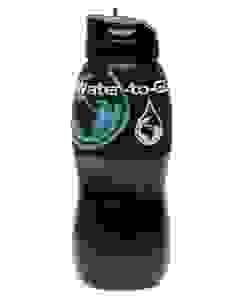
This is another one that might require overseas shipping, depending on where you live, but even with British pound conversion and international shipping costs, it’s still rather affordable.
The Water to Go Bottle removes 99.9% of biological contaminants (including viruses) and certain harmful chemicals, using a NASA-developed technology that removes particles from the water without using a “real” filter, but through a process called adsorption, though it also includes a carbon component for soaking up chemicals.
(The site claims it removes 99.9% of all microbiological contaminants, but elsewhere on the site they’ve listed the test results, which put both virus and bacterial removal at 99.9999%, and other types at 99.99%. I’m not sure what the 99.9% refers to.)
There’s a smaller bottle available as well, but the numbers here are for the one in the photo. Prices on their site are listed in British pounds, and the numbers here assume a conversion rate of 1 British pound equal to 1.5 American dollars, and don’t take into consideration the international shipping costs:
- Unit price: $37.50
- Replacement parts: $13.5 per cartridge
- Lifespan: 200 liters
- Initial water treatment cost: $0.18 per liter
- Recurring water treatment cost (cartridges): $0.067 per liter
- Empty weight: 4.8 ounces (138 grams)
Get it here.
5) Katadyn MyBottle: $60
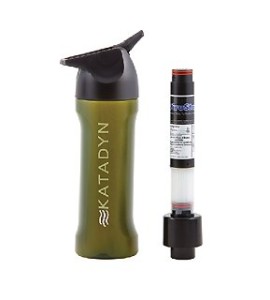
The Katadyn MyBottle uses a combination of filtration and iodine purification, to remove particles, and kill whatever microorganisms are inside. This is highly effective, but means the water will taste like iodine. This used to be the standard method for hikers everywhere, but some of the newer models, such as those listed above, manage the same level of safety without any added chemicals, which is likely to be a preferable solution for most people.
But it works, so I’m including it here, as it came in quite handy for me on trips through Eastern Europe and South America, and it’s quite simple. Besides, I don’t think it tasted so bad. I think it has been bested by some of the newer models out there, both in terms of non-iodine performance and cost-effectiveness, but it’s still quite functional, particularly if you use it only occasionally, in which case its moderately-cost-effective performance won’t add up too much.
- Unit price: $60
- Replacement parts: $35 per cartridge
- Lifespan: 150 liters
- Initial water treatment cost: $0.40 per liter
- Recurring water treatment cost (cartridges): $0.23 per liter
- Empty weight: 10 ounces (283 grams)
Buy it here.
If you DON’T need total purification
So this probably sounds horrifying, but there are a couple systems worth mentioning that only provide partial filtration, specifically focusing on removing biological contamination, which is the type of thing that works perfectly fine for hikers, but is not necessarily ideal for travelers, who will run into metallic tap water and maybe a virus or two. But if you’re hiking in North America, these might work for you:
7) SteriPEN Water Purifier systems: $100 (depending on the model)
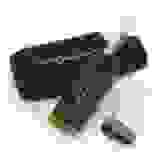
Although I much prefer all-in-one systems contained within the bottle, this is a popular device for backpackers all over the world, so I thought I’d discuss it here.
The important thing to remember is that the SteriPEN kills the microorganisms in the water with UV light, but does not actually remove them; it’ll be safe, but you’ll drink them right up. This also means it won’t remove chemicals, metals, particles, or anything else.
It’s possible to combine this with extremely cheap carbon filter bottles, which only remove large particles and certain chemicals, and thus combining them together would provide a more complete system. The Camelbak Groove and Brita water bottles come to mind.
You also need to use clear water, because the UV light will get blocked by sediment. You really don’t want to use this on muddy water, ever. You don’t want to use any filter with muddy water, but the other filters will actually clean it, which will damage the lifespan of the filter, but drinking muddy water with a SteriPEN might damage the lifespan of you.
The SteriPEN claims battery life long enough to clean 100 liters with 4 AA lithium batteries (about $2 each), which could be even cheaper with rechargeables (seriously, why does no one use rechargeable batteries?). The manufacturer will replace the bulb for $60, so the combined cost is still fairly cost-effective over long periods, but again, you’d need a separate filter if you wanted to remove metals, chemicals, and other stuff.
- Unit price: $100
- Replacement parts: $60 bulb, batteries of varying cost
- Lifespan: Approximately 8,000 liters (bulb lifespan)
- Initial water treatment cost (SteriPEN + 4 AA lithium batteries): $1.08 per liter
- Recurring water treatment cost (batteries + bulbs): $0.10 per liter
- Weight: 4 to 8 ounces with batteries, depending on the model (115 to 230 grams)
Buy it here.
8) The Sawyer Filter Bottle: $50
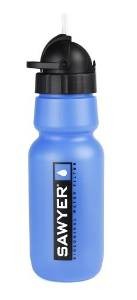
I have pointed out on many occasions that if you are only hiking in North America (and other places where viruses aren’t a problem), this is probably the best option out there.
The Sawyer bottle has a 0.1 micron filter size, which is good for everything biological except viruses, and it won’t handle chemicals, either, so it’s no good for low-quality tap water; but it’ll handle 99.99999% of bacteria, along with other bacterially-sized microorganisms (cysts, protozoa, etc), which works just fine for filling up from a river in the mountains, and is guaranteed to last for 3.7 million liters (minor note: these claims have been put to the test, and have been shown to come up short; it’s probably best to replace the filter long before the lifespan guarantee runs out).
There’s the arguable advantage of having something all-in-one, which can handle hiking and international travel and icky tap water, and some people might prefer that sort of minimalism; but if all you need is something for outdoorsy North American recreation, this is a good one.
- Unit price: $50 (though frequently found on sale)
- Replacement parts: None; buy the whole thing again
- Lifespan: 3.7 million liters (as mentioned, this claim is not sufficiently backed with evidence; it’s probably best to use it for a few months, just like the others)
- Initial water treatment cost: $0.000013/liter
- Recurring water treatment cost: $0.000013 per liter (as mentioned, it won’t last as long as they say, so this number should really be much higher)
- Weight: 5.5 ounces (155 grams)
Get it here.
There’s an in-line filter as well, for attaching to a hydration bladder, which offers the same performance.
Final thoughts
As you may have noticed, I’m a big fan of all-in-one designs. With the exception of specialized devices like the Sawyer Bottle and SteriPEN, all the options on this list can handle chemicals, bacteria and bacterially-sized things, and even those pesky little viruses (though with varying removal rates), though I would recommend using the ones with the highest removal rates if you’re going somewhere seriously questionable. Other pros and cons include some with great long-term cost-effectiveness, while others might offer swappable filters for low-grade filtration in less risky areas, and others might just fit better in your cup holder. A lot of this comes down to personal preference and ease of use, but performance is worth taking into consideration as well. But for reasons related to performance and ease of use, I’m sticking with the Grayl for now.

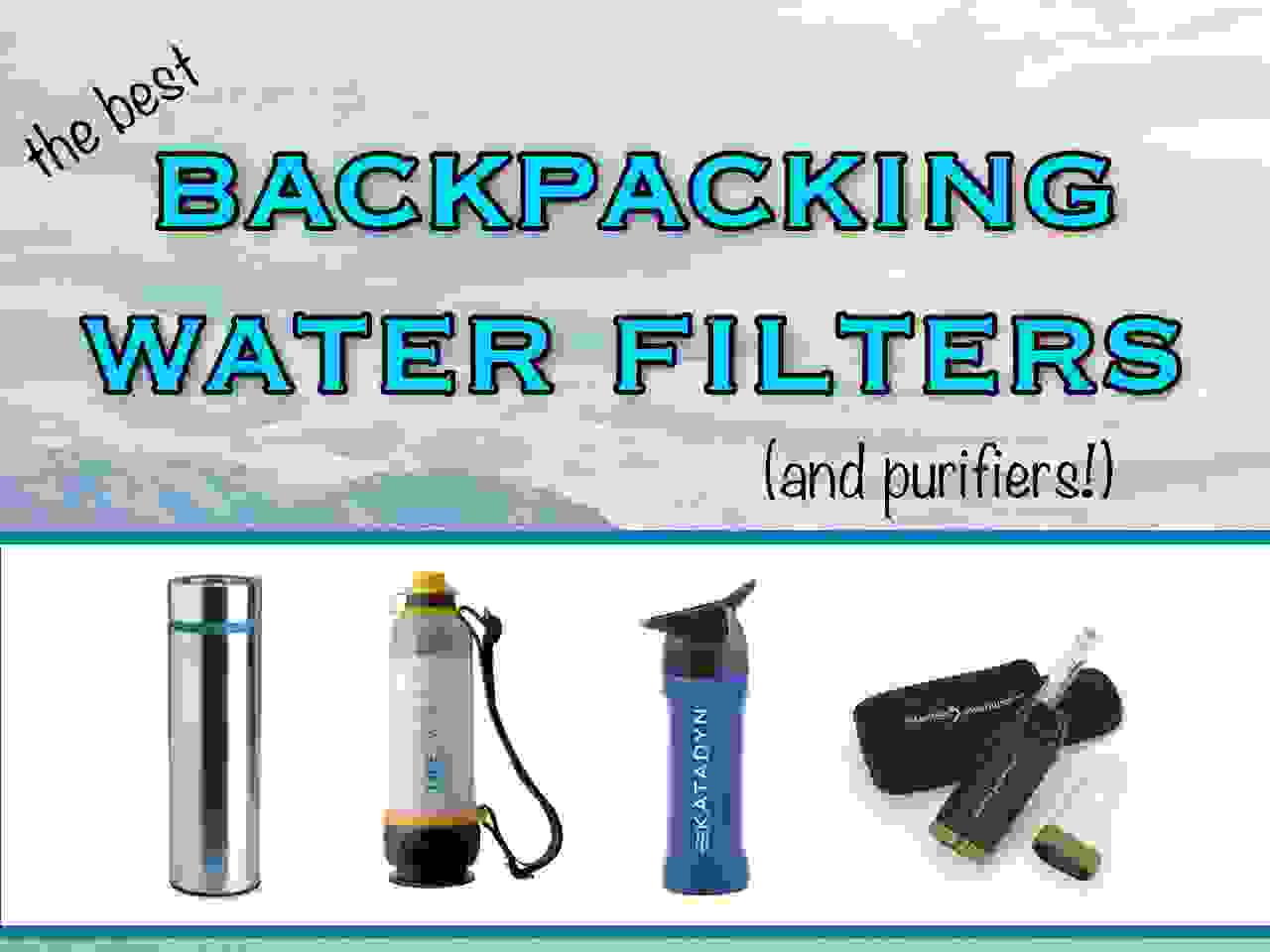



I am going to Thailand in March for 3 weeks spending one week in an elephant rescue camp near Chiang Mai then to Bangkok and Phuket staying in hotels in these places .Which filter do you think would be best I like the sound of the Grayle does this not filter out viruses
The Grayl has three different filter options, depending on what you need. The one that filters out viruses is called the “travel” filter, and it’s orange. All the options on this list will handle viruses, though.
Hi there,
I have been looking at water filtering and purifying for a little bit.
I see the merits of having something for mountain trails and another system for 3rd world travel. However, I’d rather have a single thing if possible.
I have had a look at the water-to-go system. It seems quite a new thing, and the specs are promising. The tests are all of the ‘they gave me this free bottle and it looks great so thumbs up’. I haven’t seen many real world testimonials or reviews after significant use.
Are there any good reviews? Is it a legit product?
Cheers,
Miguel
It sounds good to me too, though user reviews are never going to be accurate for water purity. A single user testing the product isn’t a scientific experiment; even if he or she uses something for a trip and doesn’t get sick, it might just be that the water happened to be clean that time, so it’s impossible to read a review and get an idea of how safe it is to use. They have some official testing numbers on their site, I think. Obviously it would be nice if some completely unrelated 3rd party did it and posted the results of every water filter on its own site, rather than each manufacturer claiming the numbers themselves, but oh well.
Hey,
I’m going to travel to Ghana for three months. It’s pretty easy to come by “safe” water (or beer, which, from experience, does not dehydrate you too much, has a guaranteed seal and the alcohol is a plus, too), and I won’t do any trips through the bush.
Speaking from experience, though, it might be handy to have a filter and/or purifier, just in case. Not for river or lake water, though.
Can you recommend any system for this? I’m not sure about viral contamination of tap water in Ghana, which is why I’m not sure about just getting a lifestraw solution (as I said, only for emergencies).
Thanks in advance!
I wouldn’t take any chances anywhere on that continent…I’d definitely get something listed here, or buy bottled water the whole time. However, if you’re planning on purifying water only in certain cases, such as drinking beer most of the time and only needing water sometimes, then you could easily just use iodine tablets to purify, which will be cheaper. I don’t like using iodine for long-term, all-day-every-day water needs, since you can just get one of these filters instead, but iodine is super cheap, barely takes up any room, and works just fine. If you only need to use it occasionally, the minor inconveniences are no big deal.
I’ve read somewhere that household bleach works, too. Is that viable or are you more likely to get yourself killed, since bleach really isn’t something you should ever ingest? Sounds like I’d go for the iodine tablets.
Thanks for your quick and elaborate reply!
I think it’s possible to drink tiny amounts of bleach without dying, but it just seems way too problematic. Iodine works just fine, hikers use it all the time, and it won’t ruin your clothes if you spill a few drops, whereas bleach totally would.
hi,
3 of us are going to be cycling in Peru and Chile, mostly back country roads looking at the Katadyn Pocket, what are your thoughts.
If you’re traveling with a group, it potentially starts to make more sense to get a single filter instead of individual items. Personally, I prefer having my own individual device, but that’s because I mostly travel alone, so it makes more sense that way. But the Katadyn Pocket says its filtration is 0.2 microns…which is fine, but there are other filtration devices out there, particularly from Sawyer, that manage 0.1 micron filtration, and it’ll probably be cheaper just to buy 3 of them and have one for each person. The Sawyer Water Filter Bottle is that one, and it goes for about $50. It won’t remove viruses, though…viruses are quite rare, and they’re more common in countries like Africa than South America, but if it’s something you’re worried about, you’d want to supplement the Sawyer with iodine tablets or UV lights, or get one of the filters listed above that can remove viruses as well.
A quick heads up for a portable purifier that should get more attention, the SolarBag.
The only portable water purifier that has proven it can destroy and remove virtually every lethal toxin and pathogen without […]</cite
Last year we went to Costa Rica with vague and conflicting info about tap water safety. 2 weeks of bottled water, boiling for refills, and several “oh no what have I done” moments after habitually ordering tap water in restaurants… Soon after that my family went camping on the Poudre River in Colorado and ran out of drinking water. Had to “test” several highly unsatisfactory water treatment methods on river water. Yuck. Since then I’ve been looking at options to take care of both of those situations in the future. For a while I was leaning towards those tiny Sawyer filters with the squeeze bags and the 100,000 gallon limit, possibly backed up by a steripen. But maybe Grayl could do the same job with fewer possible failure points.
REI just mailed me a 20% off coupon. Very tempted to go use it on a Grayl Quest Trail. My main concern about that is the cost of replacement cartridges. Have you had any problems with cartridge life span? Do they last long enough for practical use before replacing? Does using + drying out + storing in a baggie significantly degrade performance?
Curious if you have any new insights after all these months.
I’ve found their life expectancy info to be accurate. It’ll last the stated 150 or so liters, so if you drink a liter a day of clear water, that’ll be 5 months of use (and longer if you use it less often). I’ve also tried removing a filter, letting it air dry, and storing it in clear plastic wrap, which seems to work fine; but the filter I used was nearing the end of its life anyway, so when I started using it again, I just decided to switch to a new one.
As for the Sawyer squeeze bags, I think it just makes more sense to use a bottle. Those tiny squeeze bags are light, but if you have to deal with that all the time, a bottle just makes more sense to me.
Here’s a Kickstarter for Naked Filter. It looks pretty similar to the other microfilters, but it is pretty inexpensive. I’ve asked them a question to clarify how they’re different from Grayl, Lifesaver, or a Lifestraw Go Water Bottle.
https://www.kickstarter.com/projects/598593213/naked-filter-clean-water-for-every-body/description
They’ve been in contact with me and it’s a good one. It’s not capable of handling viruses, but it can handle chemicals and bacterially-sized biological contaminants, and the expected pricing is very affordable.
I was looking at that one. What I don’t get is what makes it even the slightest bit different from what Sawyer and others already offer. Except maybe a little cheaper up front. (But more expensive per liter over time.) The lack of virus removal greatly limits usefulness in places that need it most. Though maybe the impoverished of the world will fight off hepatitis easier if they don’t have giardi too… But still, always good to see more competition in the market to drive innovation.
My understanding is that this new one has the same filtration capabilities as the Sawyer, but additionally has a carbon filter element that removes things like chlorine. The Sawyer is perfect for river and lake water, where you’re most likely in need to biological filtration, whereas this new one would also make tap water taste better, so it’s nice for people in a city who want to go on a hike too.
Ordered a Grayl Quest from REI yesterday. After the 20% off coupon and sales tax it ended up a hair under $50. Will give it a good camping test before too long. The french press style of usage looks great for filling up other bottles.
You mentioned Water To Go. I really like that one for its low replacement filter cost. Due to virus removal it might actually be better for disaster relief efforts and world travelers than Naked Filter. Not sure how much international shipping would be for people outside the UK though.
Thanks for coordinating so much useful information! This particular aspect of travel gear has a lot of potential.
I work on an air-ramp at an airport and there is a water faucet/fountain that tastes pretty gross. I have to find a less-conveniently located fountain in order to drink. I’m interested in finding a filter/bottle combo product that can make chemically/metallic tasting water taste fresh- but also the smallest micron filtration too.
I’m wondering what it is I should be searching for- or what is it about a filter/purification that makes the water taste better that I should be paying attention for in product description?
I live in Southern California so I’m aware I’m not necessarily in demand of a product that catches viruses but I do travel so I figure why not have a product that handles both as best possible?
Or might it be worth my while to have two separate bottles? One for work and local hikes and another for travel?
Oh, one more question: are there desalination bottles by chance?
So the only method I’m aware of that’ll remove chemicals from the water so it won’t taste terrible is carbon filtration; this is because the chemicals might only be one molecule in size, which is far too small for any filter to catch, whereas carbon is incredibly absorbent, so it soaks them up. I didn’t include those on this list, because I wanted to highlight only the best, all-in-one options out there, but plenty of inexpensive filters will do this, including the Camelbak Groove and Brita water bottles, and the replacement filters are pretty cheap too. The Grayl also has interchangeable filters, one of which is specifically designed for tap water filtration, and you can switch the filter to a different version when going hiking or something.
If you want something that can handle most tap water chemicals and biological contaminants, the options would include the Grayl (with the “trail” filter), Katadyn, and Lifesaver, as well as a few alternatives that haven’t found their way to this list (I’ve been meaning to do an update, and I just haven’t done it yet), which include Water to Go, Aquamira, Travel Tap, and the currently-in-Kickstarter Naked Filter. Any one of those except the Naked Filter will also handle viruses, though in the case of Grayl and Aquamira you’ll need to select the specific filter that can handle them when you buy it. They’re properly labelled, so it’ll be easy.
If you’re looking for the most cost-effective options, carbon filters such as the Camelbak Groove and Brita water bottles will be the cheapest. Brita’s carbon filter replacements are currently about $7 on Amazon for a pack of 2, each of which is good for about 150 liters, so it might make the most financial sense to get one of those for tap water, and something else for hiking; but if you simply want an all-in-one solution instead of multiple bottles, they’re not really going to become prohibitively expensive, even if you use them constantly. The Grayl’s cheapest filter is $15 and lasts 150 liters (approximately 3 months), so that’s still just $60 a year for clean tap water.
I think you’re out of luck on desalination. I’ve never even heard of an easy way to do that, especially in a bottle…
Great article, thank you! I often work in Nepal/Bangladesh some African countries as well and in the past used solely the steripen as I didn’t know there even were different options. I’m now preparing for my next trip to Nepal and Bangladesh where I have to filter/purify every drop I drink. Even bottled water sold in markets is not clean so everything has to go through a treatment. The water is really pour quality over there and it’s what causes sickness in majority of cases to foreign travelers.
After reading bunch of reviews including yours I am leaning towards getting the Grayl as I like the look of it and the fact that I will not need another battle. It’s all in one and looking pretty cool. However I just wanted to ask you and confirm that the filter/purifier in it doesn’t use any chemicals and it is equal in what it can do to the steripen system. I have used the steripen for years so switching to something new makes me ask all this.
Thank you for your suggestions!
Yup, it uses no chemicals, and it’s actually better than the Steripen in terms of filtration; the Steripen kills whatever is in the water, whereas the Grayl actually removes it. For biological contamination, there’s not much difference (except it’s kinda icky to know you’re actually drinking those dead bugs if you’re using the Steripen), but the Grayl will additionally remove chemicals, sediment, and other things, so it’ll taste better too.
PS: I’m leaving the typo of “I will not need another battle” as-is, because it works so well.
Hey Jana and Snarky, I will also be heading to Nepal for about 15 days but I will be bringing a bunch of about 26 people. Previous trip was horrible as all of us came down with a stomach bug. I am looking at the Grayl or Lifesaver to purify the water before drinking for all of us but that might seem too slow and the filter for the Grayl is much too expensive too. I’m considering either this approach or getting a Water-to-go for everyone.
Any opinions?
I can’t think of a better option than just to give everyone their own individual filter bottle, but there’s also the option of a group filter for everyone. The best one I’m aware of is known as the Sawyer Point Zero Two (because of its .02 micron filter size, which is small enough to catch viruses). It’s a gravity filter, so you’d suspend a bucket and hang it up high. There’s a lot about that that’s inconvenient, though, such as when everyone’s thirsty and all 26 people have to stand in line to fill up one at a time from a relatively slow filter. I would say bottles are better.
Hi, Could you please advise which would be the best for me to use. I need light to carry and something that filters out bacteria and viral. I am hiking the Kokoda Trail in Papua New Guinea. Many thanks
All of these will work, except for the Sawyer, which can’t handle viruses. All the other ones will be great.
I just used my Grayl LEGEND W/ TRAVEL PURIFIER for a 3-day hike… how do I clean the filter so that I can shelf it and so that it’s ready for use the next time I go travelling?
I just let it dry out and then wrap it in plastic wrap. Seems to work fine. I don’t think you can “clean” the filter in the sense of removing the particles that the filter has already pulled out of the water.